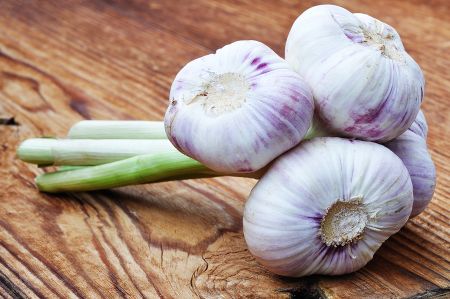

Yes, it is amazing how something that makes food smell so good can make a person smell so bad, but garlic has a list of health benefits that no one can put down. From helping to manage cholesterol and blood sugar levels, to prevention of gynecological disorders, to supporting immune function, the “stinking rose” gets the job done.

Many stories and superstitions attribute plenty of properties to garlic: from hanging it on the doorframe to keep vampires and demons (or at least friends) away, to being a magical natural and ultimate panacea. Studies have suggested that garlic has the ability to heal the body both internally and externally, so much so that you can find combinations of it in several remedies.
The basic component that gives garlic its medicinal properties is allicin – a phytochemical made available for absorption only after garlic cloves have been taken apart and crushed. This substance protects garlic against bacteria, viruses, and other intruders. Allicin is then broken down and into other components, including antioxidants and antitoxins. The power of these properties differs depending on heat, dryness, or freshness of the garlic.
Find out which foods you should never eat by clicking here.
Garlic’s beneficial properties
The list is long and based on many studies, which have produced corroborating results. There isn’t an area in which garlic hasn’t been shown to play an impressive medicinal role, making all the praise it receives seems justified.
Heart disease: garlic may reduce the risk of heart disease, disorders, and arrests. It may reduce bad cholesterol (LDL) levels, helping to prevent hardening of the arteries, and may reduce blood pressure.
Parasites and infections: garlic has been used as a natural antibiotic against bacteria, intestinal worms, acne, and visual disturbances caused by internal infections, viruses, and colds. It has been recommended as a topical rub for gout and arthritis, and garlic oil as drops for ear infections.
Chronic diseases: garlic contains antioxidant components that fight free radicals in the body. This may reduce the risk of cancers by preventing and destroying cancerous cells. Garlic’s potential as a treatment for cancer has been the subject of several scientific studies.
Fungal infections: garlic’s components have been found to help the body fight against fungal infections like candidiasis from Candida albicans.
Stings and bites: garlic eaters tend to get stung less by mosquitos and insects. Eating garlic has been used to help fight infection and overcome the effects of snake or rabid dog bites.
Indigestion: garlic stimulates the secretion of digestive juices and bowel movements.
Kidneys: garlic has been shown to reduce the probability of kidney disorders, dissolve kidney stones, and act as a diuretic.
Respiration: garlic has been observed to act as an expectorant, removing phlegm, and may be excellent for diseases of the respiratory tract, and to soothe hoarseness and persistent coughs.
Diabetes: garlic has been observed to reduce blood sugar levels
Gynecology: garlic may prevent gynecological disorders and relieve menstrual pains. Garlic oil has been used to heal vaginal infections and genital warts.
But garlic has a few faults…
The smell: If you had garlic for lunch you’re probably not in for a particularly romantic evening or impressive business meeting. Garlic has a smell that gave it the nickname “the stinking rose,” and while this can be heavenly during cooking and dining, it gives those who dare eat it very bad breath. In those who eat large amounts of fresh garlic daily, the smell often comes through the skin. Paradoxically garlic’s Achilles heel that gives it such a bad smell is the allicin – the same basic component that also gives it its wonderful medicinal properties. The smell can be toned down in cooking, but this also can destroy the active properties.
Garlic allergy: Even if you’re not especially garlic intolerant, increased eating of allicin in relation to body tolerance can cause unpleasant skin stimuli, redness, and warts. Those who have even less tolerance to garlic might feel heartburn and flatulence. Some, however, are truly allergic to garlic. Their symptoms include stomach pain, fever, headache, and a skin rash. These effects might also appear in people who aren’t allergic to garlic at all, but who consume massive amounts of garlic (over 10 garlic cloves per day for most people).
Digesting garlic: even though garlic contributes to digestion by increasing the secretion of digestive fluids, digesting garlic on its own is demanding and creates a burden on the stomach’s walls and duodenum, especially for people who are sensitive and/or have gastric ulcers.
How to avoid “garlic breath”
It is possible to avoid the level of odor caused by eating garlic by using oral hygiene methods like using breath spray or mouthwash, brushing and cleaning your teeth, using dental floss and brushing the tongue. Sprays come in different strengths and they should be tested individually to see how they perform.
Other methods to reduce odor are: chewing parsley, mint, fennel, dill, cloves, or a fresh orange. This can dissolve garlic’s offensive odor.
A big factor in controlling odor is that garlic eaters find it hard to notice the smell, unless it’s particularly strong. Also, the sense of smell is subjective, and one person may be affected an offensive odor and not another. One way to check is by having a person get close enough, who didn’t eat garlic, with whom your relationship is strong enough to be completely honest with you.
Perhaps the best solution for garlic breath is to make sure you’re surrounded by friends who are also garlic eaters.
Note that this does not solve the issue of garlic-scented skin in major users – for this, drinking green solutions, such as chlorella, or rinsing the skin with fresh lemon are popular methods, in addition to using deodorizing lotions, powders, and sprays.
How much and how to eat garlic
If you’re eating garlic used to spice up food, eat according to taste, based on your body’s reactions. Combine it with the food you eat at will. When it comes to using garlic for its medicinal properties, however, you should eat it according to these following rules:
- Garlic shouldn’t be eaten by itself to prevent disorders of the digestive system.
- The amount of garlic needed is based on the body’s size. It ranges from one to two cloves per day.
- Crush the garlic around the time you intend to eat it. The active substance that gives the garlic its properties only exists when the live garlic is crushed and is destroyed about an hour after the time it’s crushed.
- Combine garlic with spreads such as humus, tahini, eggplant, or liver.
- Other ways of processing garlic might reduce its odor but will also reduce its medicinal properties related to the immune, bacterial, and antioxidant systems.
- On the other hand, cooked garlic contributes to reducing cholesterol levels and blood fats and helping the blood stream, so combining the consumption of fresh and cooked garlic is optimal to realize its benefits.
And what about garlic capsules?
Eating garlic isn’t so practical on the social front, so one of the alternatives for people interested in garlic’s advantages is consuming “odorless” garlic capsules. Are the capsules a perfect substitute to fresh garlic? The answer is that sometimes they are, but they need to be chosen carefully!
As stated, the most important component in garlic is allicin. The chemical structure of the allicin is very complicated. Even in fresh garlic it can only be produced after crushing the garlic, and even then its properties aren’t active for long. Therefore, conservation of allicin in capsules isn’t simple, and the differences in the amount of allicin in the capsules will also affect their price. High content means high price. Therefore, when purchasing garlic capsules, it is important to do a bit of homework or mini-research regarding the concentration of allicin, as it is not always indicated on the label.
There are usually two things that can confuse a consumer planning on purchasing garlic capsules: usually, the packages show a comparison between the capsule and the amount of garlic cloves it’s equal to. This doesn’t entirely correlate to the amount of allicin.
You may also find on packages of garlic capsules an indication of the amount of alliin that the capsule contains. However, alliin is not allicin, and it doesn’t have the properties related to allicin. The similarity in the names can create a marketing illusion and manufacturers use it to their advantage. Therefore, if you decide to purchase garlic capsules, check the amount of allicin on the label.
In conclusion: “a rose by any other name” is still worth it
Garlic is a popular topic of scientific studies, and has long gotten media attention and demand as a result. Fortunately, garlic was and still is a common vegetable-spice that dates to the early Egyptian days – meaning, it’s cheap, it’s always available, and it has a long shelf life, so for most people, there’s no excuse not to include it in your daily diet. For those who can’t – but need it – standardized odorless garlic capsules high in allicin may be an option. (Ambien)
Garlic has a dominant taste and smell, and the joy that brings to cuisine does not translate to the smell after eating it. And the stronger the smell and taste (and the more repellent), the more potent its medicinal properties. Therefore, try to find a middle ground or product that suits you, so you can consume garlic in a way that pleases your taste and meets your need, and won’t be a social obstacle.
Learn more about the Trim Down Club here.
Comments 4
Leave a Reply
You must be logged in to post a comment.




Hi, Newval. Jarred garlic has somewhat reduced properties, but some are still retained.
Hi, Danny. A popular option is a tomato juice-based shake with garlic and parsley. Celery, carrot, and even apple juice shakes can also be enhanced with a touch of garlic.
I’ve never been a garlic eater but have always heard how beneficial it it. I have used minced garlic that comes in a glass jar, for cooking. Are there any benefits in that?
Are there any Veggie drinks thatg can be made with Garlic ? I want to use in the best way possible, my pass diet has trashed my health and I plan doing anything to improve it . Thank You .